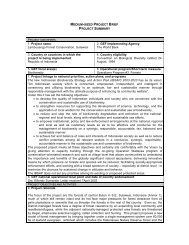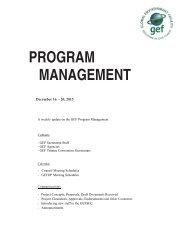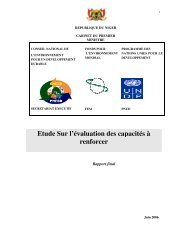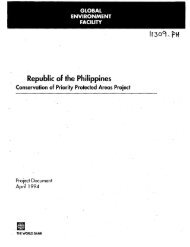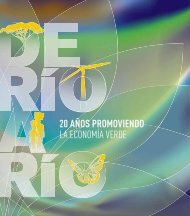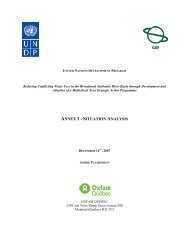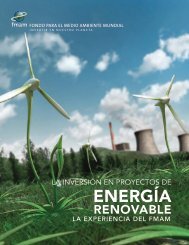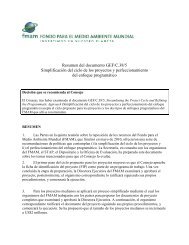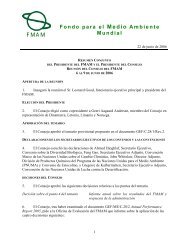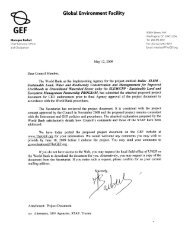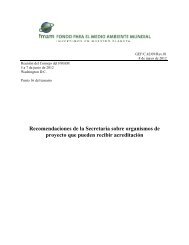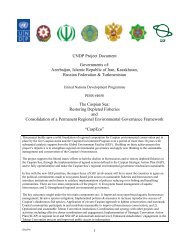Business Plan ESCO - Rivne - Global Environment Facility
Business Plan ESCO - Rivne - Global Environment Facility
Business Plan ESCO - Rivne - Global Environment Facility
Create successful ePaper yourself
Turn your PDF publications into a flip-book with our unique Google optimized e-Paper software.
Municipal Energy Service Company of <strong>Rivne</strong> <strong>ESCO</strong>-<strong>Rivne</strong><br />
The above mentioned goals can only be achieved if the actors are organised around their<br />
common problems and interests. It is therefore recommended that stakeholders form the<br />
following types of organisations:<br />
• Community Organisations (CO): a CO is an organisation of people living in the<br />
proximity (neighbourhood, residential buildings) sharing (a) common interest(s)<br />
related to their social and economic development in general and to energy efficiency<br />
in particular. Residents and other interest groups are assisted by the project to form<br />
their own organisation in order to harness their potential to help themselves.<br />
• Functional Groups (FG): FGs are formed from members from within the CO, to<br />
participate and represent the community or interest group in specific / specialised tasks<br />
- such as planning and monitoring of energy efficiency measures/initiatives.<br />
The organisational structure best suited has to be discussed with the different COs from case<br />
to case.<br />
The community development process essentially takes place in four distinct phases:<br />
Phase I: introduce the project and <strong>ESCO</strong> approach in the communities, identify and<br />
establish partnerships with potential (pilot) COs (Interest groups, neighbourhood<br />
committee, AOA, etc.);<br />
Phase II: formation of (pilot) CO, identify most suitable organisational set-up;<br />
Phase III: identify communities’ needs and formulate (pilot) energy efficiency<br />
projects;<br />
Phase IV: planning and implementation (operational and financial resource<br />
mobilisation).<br />
At the beginning of the process a stakeholder workshop should be conducted, aiming to:<br />
• Introduce the project and approach (<strong>ESCO</strong> mechanisms, energy/cost saving potentials,<br />
etc.) to as many stakeholders as possible, including regional and municipal authorities,<br />
public and private enterprises/businesses, neighbourhood and other interest groups,<br />
potential partner NGOs, etc.<br />
• Identify main problem areas in the field of energy efficiency;<br />
• Discuss possible solutions and interventions.<br />
Consumers can only be convinced about the viability of an approach based on their<br />
involvement and participation - and potential investors and donors can only be attracted - if<br />
the <strong>ESCO</strong> approach can be made visible through successful examples to a wide public.<br />
6.3 Public Relations Strategy<br />
The <strong>ESCO</strong>-<strong>Rivne</strong> public relations concept foresees permanent development in accordance<br />
with the company’s development stage. It means that PR strategy will change depending on<br />
the <strong>ESCO</strong>’s evolution (projects’ implementation, attraction of new investors or customers,<br />
obtaining of grants, etc.). Since <strong>ESCO</strong>-<strong>Rivne</strong> is a relatively new company and the energy<br />
service business is not well-developed in Ukraine, the PR concept of or company is based on<br />
three critical points:<br />
• Stage I: <strong>ESCO</strong>-<strong>Rivne</strong> image formation with focus on peculiar market segment<br />
(energy efficiency and energy saving technologies);<br />
• Stage II: Efforts for the firmly establishing on the gained market;<br />
• Stage III: Innovation activity for the market expansion.<br />
The detailed PR-concept of <strong>ESCO</strong>-<strong>Rivne</strong> is done in Annex.<br />
<strong>Business</strong> <strong>Plan</strong> - 2005 Page.28 from 31



